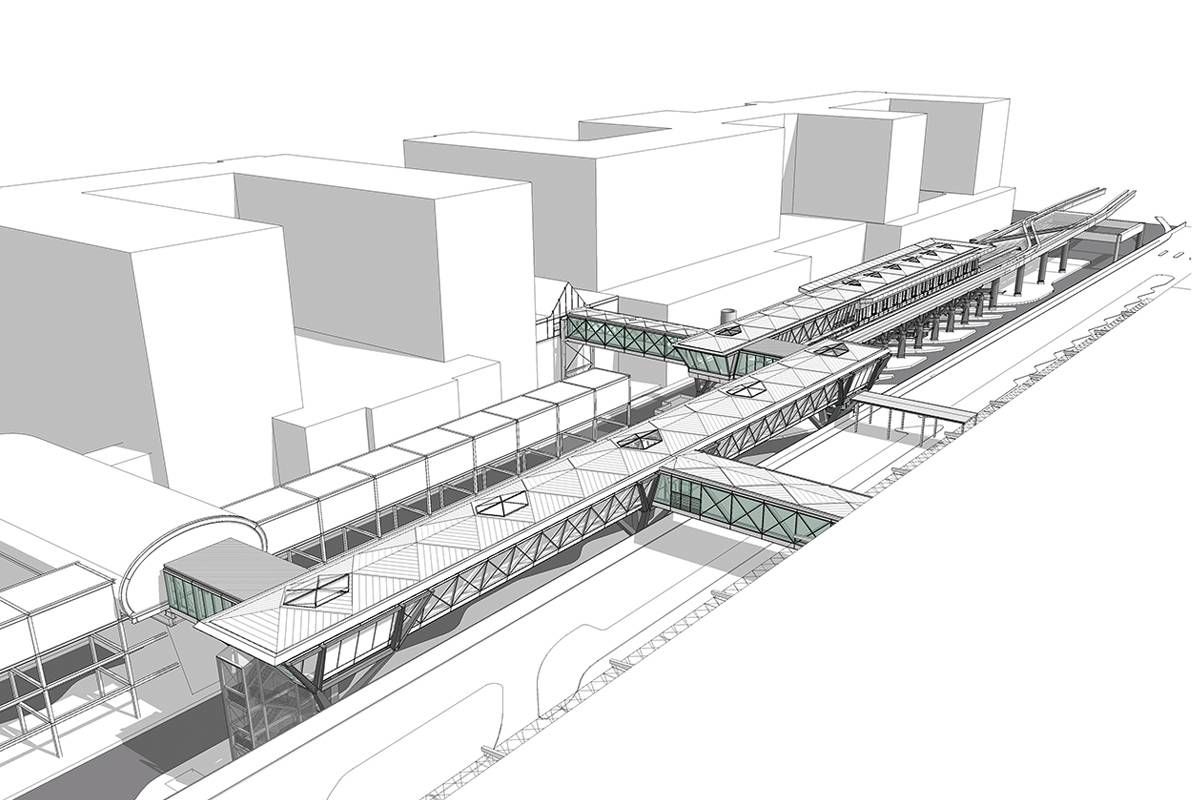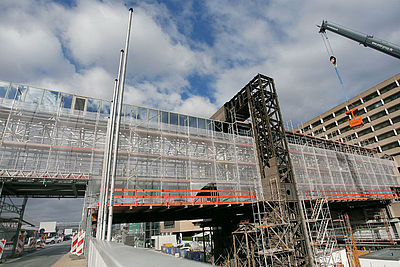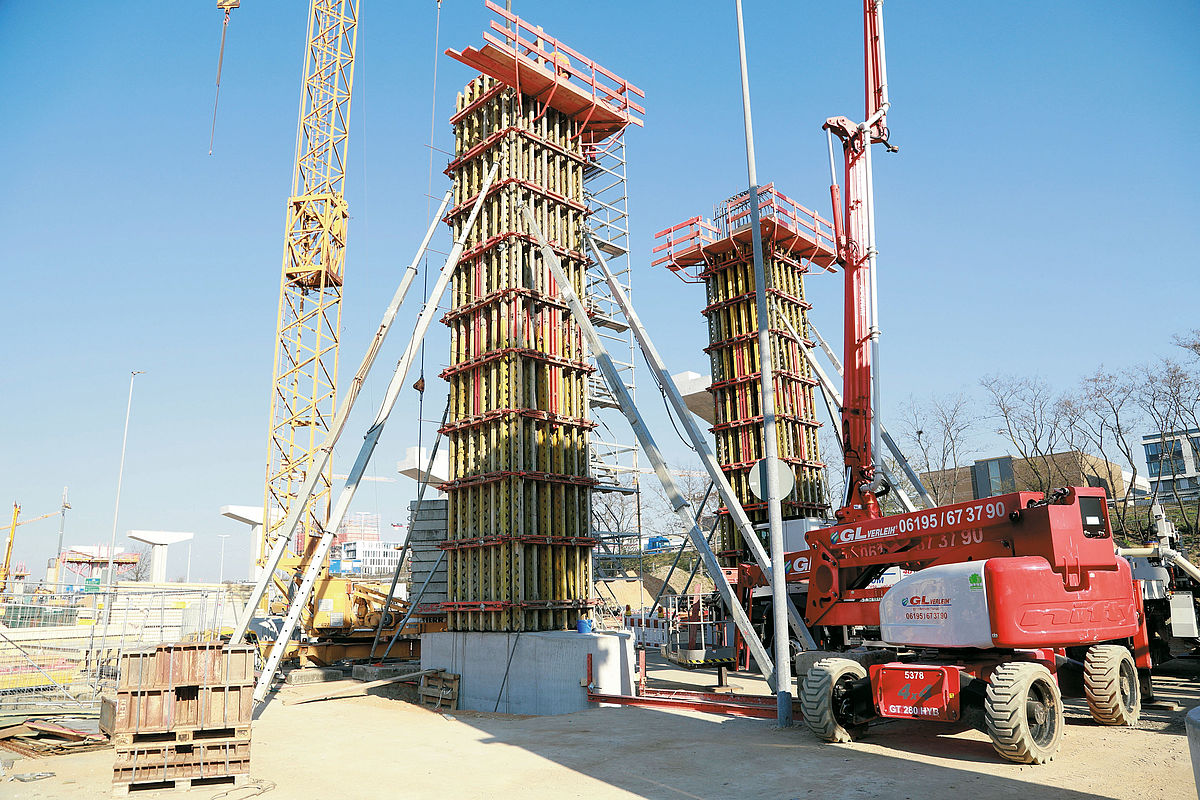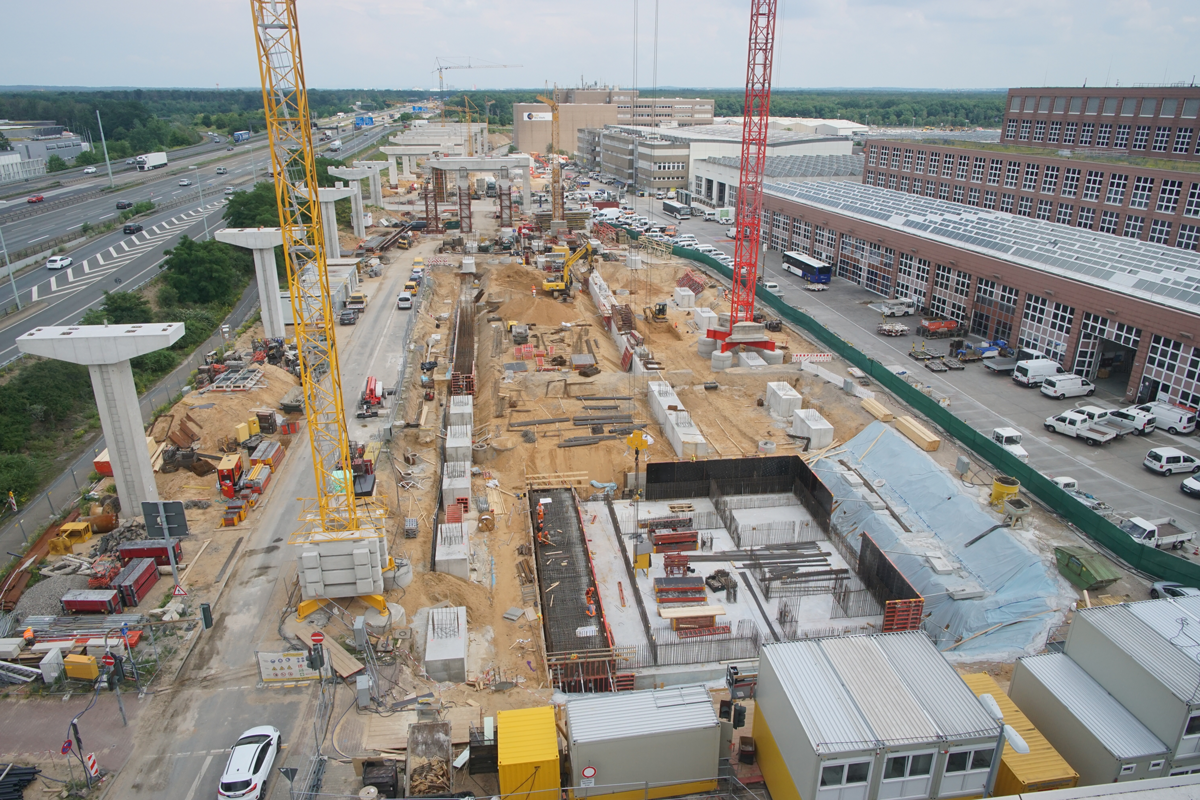
From Terminal to Terminal
In Eight Minutes to Terminal 3
Machines and construction workers are busily digging and building in the south of Frankfurt Airport to create the new terminal, which is scheduled to be completed in 2024. But how will passengers, visitors and employees get from there to Terminals 1 and 2 and back? After all, two runways separate it from the rest of the airport. Wolfgang Holzhausen and other planners have been racking their brains for years to solve this puzzle. “I started developing ideas for the infrastructure at the airport back when I was still an engineering student at Darmstadt Technical University, and since going to work for Fraport I’ve been fleshing out a solution that I originally presented in a term paper,” says the transportation expert.
Content
- From Terminal to Terminal
- In Eight Minutes to Terminal 3
- Several Years of Planning Work to Ensure a Safe, Reliable System
- Direct Paths and Smooth Processes
- State of the Art
- From Planning to Construction
- First Milestone: Selection of the System Supplier
- Northern Track: Supporting Pillar "69" is the First
- The Central Workshop: First the Carcass, Then the Equipment
 Wolfgang Holzhausen explains in the video where the new Sky Line is being built. (December 2018)
Now he is responsible for planning and implementing a new Sky Line train that will let passengers transfer smoothly and quickly between Terminal 3 and the two existing terminals as well as the regional and long-distance train stations.
Wolfgang Holzhausen explains in the video where the new Sky Line is being built. (December 2018)
Now he is responsible for planning and implementing a new Sky Line train that will let passengers transfer smoothly and quickly between Terminal 3 and the two existing terminals as well as the regional and long-distance train stations.
Several Years of Planning Work to Ensure a Safe, Reliable System
When Terminal 2 was inaugurated back in 1994, its planners faced a similar challenge. To master it, they developed a completely autonomous, driverless transportation system also called the Sky Line that ever since has been shuttling passengers between Terminals 1 and 2 without a break. And it continues to do its job reliably today. Initially the possibility of extending the existing Sky Line route all the way to Terminal 3 in the south of the airport was considered. Unfortunately, however, it is designed primarily for transit passengers,
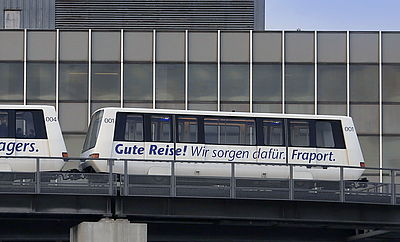 The Sky Line has been running between Terminals 1 and 2 since 1994, when it became Germany’s first driverless transportation system.
and the trains are limited to two cars each. It therefore wouldn’t be possible for other travelers to ride it to Terminal 3 without creating bottlenecks.
The Sky Line has been running between Terminals 1 and 2 since 1994, when it became Germany’s first driverless transportation system.
and the trains are limited to two cars each. It therefore wouldn’t be possible for other travelers to ride it to Terminal 3 without creating bottlenecks.
Instead, Holzhausen and his team have designed a parallel transportation system with separate tracks. Passengers arriving by rail can conveniently board it at a new station behind
 The new Sky Line will optimally link the new terminal to the existing airport facilities.
Terminal 1. Until the expansion of station C is realized, it will be possible to change between the “old” and “new” people movers at the Terminal 2 station, which was conveniently prepared to permit the addition of two more tracks when constructing the original Sky Line back in 1994. Travelers coming from or heading to Terminal 2 can also use it to get on and off. After a brief stop there, the new Sky Line will travel from Terminal 2 alongside the A5 motorway straight to Terminal 3.
The new Sky Line will optimally link the new terminal to the existing airport facilities.
Terminal 1. Until the expansion of station C is realized, it will be possible to change between the “old” and “new” people movers at the Terminal 2 station, which was conveniently prepared to permit the addition of two more tracks when constructing the original Sky Line back in 1994. Travelers coming from or heading to Terminal 2 can also use it to get on and off. After a brief stop there, the new Sky Line will travel from Terminal 2 alongside the A5 motorway straight to Terminal 3.
Direct Paths and Smooth Processes
The new system will thus supplement the existing Sky Line. Like the older system, it will be driverless and operate on two tracks. It will take about eight minutes for
 The new Sky Line train: the track path shown in the film
travelers to get from the long-distance or regional train station to Terminal 3 – any day of the year. Trains will run at two-minute intervals to make sure that passengers can catch connecting flights with transfer times as short as 45 minutes. Everything is also planned so that the two systems will mesh smoothly. This includes timing the trains so passengers can easily switch between them in the enlarged Terminal 2 station and the expanded station C.
The new Sky Line train: the track path shown in the film
travelers to get from the long-distance or regional train station to Terminal 3 – any day of the year. Trains will run at two-minute intervals to make sure that passengers can catch connecting flights with transfer times as short as 45 minutes. Everything is also planned so that the two systems will mesh smoothly. This includes timing the trains so passengers can easily switch between them in the enlarged Terminal 2 station and the expanded station C.
While traveling the 5.6 kilometers between the south and north of the airport, the new trains will accelerate to speeds up to 80 km/h. On the way from the new station behind Terminal 1, which serves the long-distance and regional train stations, past Terminal 2 and then southward adjacent to the motorway, the new Sky Line trains will descend to ground level along the motorway and then rise back up to stop at the Terminal 3 station.
State of the Art
Driverless Operation Unlike driverless cars on roads, in which someone can still take the controls when necessary, people mover trains completely dispense with a human operator. This works safely because they run on a dedicated track and are bound to the rails by derailment-proof mechanical tracking systems, plus there are partitions at the station platforms to prevent waiting passengers from straying or falling onto the rollways. Driverless systems like this enable a high level of operational stability. It would be impossible for the trains to run at such short intervals or stop so precisely with manual operation.Like most driverless people movers, the cutting-edge new trains will be bidirectional. The new Sky Line will be able to carry two different passenger groups. All outbound passengers and Schengen transfer passengers will be able to use one or two publicly accessible cars, while non-Schengen transit passengers ride separately. A new building for controlling and servicing the automated Sky Line trains is being built to make sure that up to 4,000 passengers per hour and direction can travel between Terminals 1 and 3 via Terminal 2. The two-part facility integrates a central control room and a warehouse for parts and materials. The main building has seven floors while the workshop makes do with two. Pillars prop it up to a height of 16 meters, level with the Sky Line tracks. Like Terminal 3, this facility features a sustainable design that includes a planted roof and a 620-square-meter photovoltaic system able to generate up to about 100,000 kW/h of electric power a year.

From Planning to Construction
First Milestone: Selection of the System Supplier
In March 2018, a major step was taken toward implementing the vision that had already been worked out on paper: a decision on who would supply the new Sky Line.
“Contracting the new Sky Line is a key strategic milestone in efficiently linking our future Terminal 3 with the existing Terminals 1 and 2 and the airport’s public transportation network, including the long-distance and regional train stations,” stated Dr. Stefan Schulte, Chairman of the Executive Board of Fraport AG, the company that operates Frankfurt Airport.
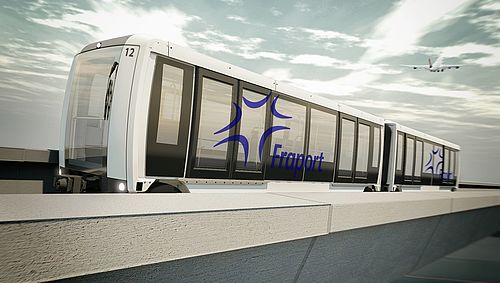 Large plate glass windows will provide passengers riding the new Sky Line trains with a sensational view of the airport.
The system will be provided by a consortium consisting of Siemens, the Max Bögl Group and Keolis, who possess many years of experience with automated driverless transit systems. The new system will be launched with 12 two-part vehicles that will circulate between Terminal 3 and the north of the airport. The consortium will provide the vehicles along with the control system and power supply, in addition to building part of the tracks and providing all of the required equipment and installations for them.
Large plate glass windows will provide passengers riding the new Sky Line trains with a sensational view of the airport.
The system will be provided by a consortium consisting of Siemens, the Max Bögl Group and Keolis, who possess many years of experience with automated driverless transit systems. The new system will be launched with 12 two-part vehicles that will circulate between Terminal 3 and the north of the airport. The consortium will provide the vehicles along with the control system and power supply, in addition to building part of the tracks and providing all of the required equipment and installations for them.
Northern Track: Supporting Pillar "69" is the First
The next step for the new Sky Line is to use concrete and steel on the construction site instead of a drawing board and computer in the office. The first bored pile work for the route began in July 2019. A total of 350 bored piles are driven into the ground with special equipment. Where classic hammerhead supports or concrete frames are used depends on several factors. For example, frames are needed as a substructure if normal roads are to run underneath them or if more than two roads are to be laid on top of them. Six supporting pillars will be erected initially, with supporting pillar number 69 being the first one. At least four bored piles with a diameter of 1.20 meters each serve as a foundation to ensure that all supporting pillars stand securely in the airport ground. So it is not only on the Terminal 3 construction site itself that deep digging is being carried out; heavy equipment drills several meters into the ground in the north-eastern part of the airport. By the middle of 2021, the substructure for the new Sky Line is scheduled to be ready: 47 individual supporting pillars and 17 frames for the route will already indicate where the autonomous rail system will operate 365 days a year in the future. Work to build the two other parts of the new automated Sky Line track―the central and southern sections―will kick off in the second half of 2020.
In the second construction phase for the northern section, the guideway will be created by placing and joining a large number of modules. Each module is completely preassembled and supplied in one piece. Since the columns will be spaced between 20 and 60 meters apart, every module is different. What all of them have in common is their enormous weight of up to 200 tonnes. Only a few of the special cranes able to do the job are available in Germany, and even so it will take two of them to lift most of the modules in a tandem lifting procedure.
Accurately placing these heavyweights in the crowded conditions in the north of the airport is proving to be a major logistical challenge for the planners. Precise planning and coordination are essential to ensure that Frankfurt Airport can continue operating with only minimal disruptions while work proceeds to meet this important prerequisite for its future success.
On site, the railings, emergency walkways and the guide rails for the vehicles are then installed just like the electrics for lighting, switch control or signal transmission. The next step is the track itself: Depending on the size and weight, sections of the concrete roadway are produced on site. Smaller sections can already be produced and delivered at the factory. In order to keep the carriageway operational even in cool temperatures, all running surfaces of the carriageway are equipped with copper pipes. Later on, heating wires will run through these tubes and, similar to underfloor heating, will ensure smooth running.
The Central Workshop: First the Carcass, Then the Equipment
Construction of the new facility, like Terminal 3, also began by digging a big hole. In February 2020, excavators and graders arrived to get the site ready. They were tasked with breaking up asphalt, removing earth and rubble, and leveling the ground so work to build the carcass could kick off in March.
The facility will actually comprise two linked buildings: one with seven floors plus a two-story workshop, and the preparations for them differed accordingly. The main building has a cellar, which is why a pit 6.5 meters deep had to be excavated first, followed by the creation of an up to 2.5 meter thick base plate. The workshop, for its part, sits atop 24 columns at a height of about 16 meters so that trains can roll from the maintenance hall straight onto the track. The columns rest on 58 foundation piles.
Concrete and steel will then come into play. These materials are needed to ensure that the main building, the pillars and the workshop can hover securely in the air. The carcass work is scheduled for completion by April 2021, when work on the roof and interiors will begin. The plans call for all of this to be finished by January 2022―that’s when the first new Sky Line trains will be delivered and readied for their jobs. Each vehicle reaches its future operating distance in two parts. Mobile cranes then lift them onto the driveway in the area of the workshop building. From there, the vehicles are taken to the workshop hall, assembled and intensively tested. As soon as the final construction work is completed, the workshop building is ready for its future tasks.
The Finish Line in View
In the upcoming years, the finish line will be fast approaching. According to current plans, everything will be good to go just in time for the completion of Terminal 3: that’s when the new automated Sky Line trains and the maintenance building will start operating, linking the northern and southern parts of the airport with a travel time of just eight minutes.
Home



